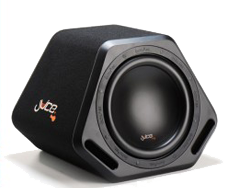 The quality of your speakers determines the ultimate quality of sound your system will produce. There are many types of speakers that you can choose from so it is good to know which one will be best suited to you and your requirements.
Single Speaker: Can reproduce the full range of sound but is probably not the best choice because if the speaker is too big it will fail to reproduce high frequencies and if it is too small it will struggle to reproduce low frequencies.
Multiple Speakers: These speakers will be individually designed specific to the sound frequency they are built to output. A tweeter is the speaker that will reproduce the high frequencies (usually above 2kHz). They respond quickly because of their size and weight, they are small and lightweight – this also means that very little power is needed to make it function.
Woofers: Produce sound at frequencies below 250 Hz and in subwoofers below 100 Hz, because so much sound is being created the woofers require a lot of power to move air. The size of a woofer can range from 10” to 18” because of the large amounts of air they need to move.
The two main specifications that you should look out for when picking your speakers is sensitivity and power handling.
The quality of your speakers determines the ultimate quality of sound your system will produce. There are many types of speakers that you can choose from so it is good to know which one will be best suited to you and your requirements.
Single Speaker: Can reproduce the full range of sound but is probably not the best choice because if the speaker is too big it will fail to reproduce high frequencies and if it is too small it will struggle to reproduce low frequencies.
Multiple Speakers: These speakers will be individually designed specific to the sound frequency they are built to output. A tweeter is the speaker that will reproduce the high frequencies (usually above 2kHz). They respond quickly because of their size and weight, they are small and lightweight – this also means that very little power is needed to make it function.
Woofers: Produce sound at frequencies below 250 Hz and in subwoofers below 100 Hz, because so much sound is being created the woofers require a lot of power to move air. The size of a woofer can range from 10” to 18” because of the large amounts of air they need to move.
The two main specifications that you should look out for when picking your speakers is sensitivity and power handling.
What to Look For When Choosing Car Speakers

CAC Admin |
 The quality of your speakers determines the ultimate quality of sound your system will produce. There are many types of speakers that you can choose from so it is good to know which one will be best suited to you and your requirements.
Single Speaker: Can reproduce the full range of sound but is probably not the best choice because if the speaker is too big it will fail to reproduce high frequencies and if it is too small it will struggle to reproduce low frequencies.
Multiple Speakers: These speakers will be individually designed specific to the sound frequency they are built to output. A tweeter is the speaker that will reproduce the high frequencies (usually above 2kHz). They respond quickly because of their size and weight, they are small and lightweight – this also means that very little power is needed to make it function.
Woofers: Produce sound at frequencies below 250 Hz and in subwoofers below 100 Hz, because so much sound is being created the woofers require a lot of power to move air. The size of a woofer can range from 10” to 18” because of the large amounts of air they need to move.
The two main specifications that you should look out for when picking your speakers is sensitivity and power handling.
The quality of your speakers determines the ultimate quality of sound your system will produce. There are many types of speakers that you can choose from so it is good to know which one will be best suited to you and your requirements.
Single Speaker: Can reproduce the full range of sound but is probably not the best choice because if the speaker is too big it will fail to reproduce high frequencies and if it is too small it will struggle to reproduce low frequencies.
Multiple Speakers: These speakers will be individually designed specific to the sound frequency they are built to output. A tweeter is the speaker that will reproduce the high frequencies (usually above 2kHz). They respond quickly because of their size and weight, they are small and lightweight – this also means that very little power is needed to make it function.
Woofers: Produce sound at frequencies below 250 Hz and in subwoofers below 100 Hz, because so much sound is being created the woofers require a lot of power to move air. The size of a woofer can range from 10” to 18” because of the large amounts of air they need to move.
The two main specifications that you should look out for when picking your speakers is sensitivity and power handling.
